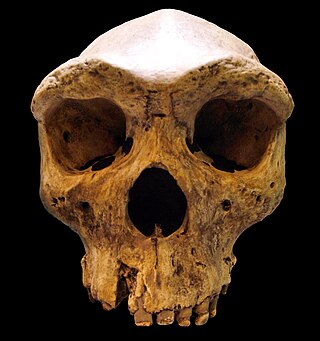Humans are a species of highly intelligent apes.
Contents
- Science
- Arts and entertainment
- Film and television
- Music
- Literature
- Other media
- Places
- Other uses
- See also
Human(s) may also refer to:
Humans are a species of highly intelligent apes.
Human(s) may also refer to:
Sapiens, a Latin word meaning "one who knows", may refer to:
Color or colour is the visual perceptual property corresponding in humans to the categories called red, yellow, blue, green, etc.
A giant is a being of human appearance, sometimes of prodigious size and strength, common in folklore.
Eternal(s) or The Eternal may refer to:
Master or masters may refer to:

Homo is a genus of great ape that emerged from the genus Australopithecus and encompasses the extant species Homo sapiens and a number of extinct species classified as either ancestral or closely related to modern humans, including Homo erectus and Homo neanderthalensis. The oldest member of the genus is Homo habilis, with records of just over 2 million years ago. Homo, together with the genus Paranthropus, is probably most closely related to the species Australopithecus africanus within Australopithecus. The closest living relatives of Homo are of the genus Pan, with the ancestors of Pan and Homo estimated to have diverged around 5.7-11 million years ago during the Late Miocene.
A troglodyte is a human cave dweller, from the Greek trogle 'hole, mouse-hole' and dyein 'go in, dive in'.
Subhuman means "less than human". It may refer to:
Avatar is a concept in Hinduism representing a material manifestation of a deity.
Crash or CRASH may refer to:
The Omo remains are a collection of hominin bones discovered between 1967 and 1974 at the Omo Kibish sites near the Omo River, in Omo National Park in south-western Ethiopia. The bones were recovered by a scientific team from the Kenya National Museums directed by Richard Leakey and others. The remains from Kamoya's Hominid Site (KHS) were called Omo I and those from Paul I. Abell's Hominid Site (PHS) were called Omo II.
Skin is a soft outer covering of an animal, in particular a vertebrate.
Human taxonomy is the classification of the human species within zoological taxonomy. The systematic genus, Homo, is designed to include both anatomically modern humans and extinct varieties of archaic humans. Current humans have been designated as subspecies Homo sapiens sapiens, differentiated, according to some, from the direct ancestor, Homo sapiens idaltu.

Archaic humans is a broad category denoting all species of the genus Homo that are not Homo sapiens. Among the earliest modern human remains are those from Jebel Irhoud in Morocco, Florisbad in South Africa (259 ka), and Omo-Kibish I in southern Ethiopia. Some examples of archaic humans include H. antecessor (1200–770 ka), H. bodoensis (1200–300 ka), H. heidelbergensis (600–200 ka), Neanderthals, H. rhodesiensis (300–125 ka) and Denisovans,

Jebel Irhoud or Adrar n Ighoud, is an archaeological site located just north of the locality known as Tlet Ighoud, approximately 50 km (30 mi) south-east of the city of Safi in Morocco. It is noted for the hominin fossils that have been found there since the discovery of the site in 1960. Originally thought to be Neanderthals, the specimens have since been assigned to Homo sapiens and, as reported in 2017, have been dated to roughly 300,000 years ago.
Homo sapiens is the taxonomic binomial species name for modern humans.
Race, RACE or The Race may refer to:

The Ndutu skull is the partial cranium of a hominin that has been assigned variously to late Homo erectus, Homo rhodesiensis, and early Homo sapiens, from the Middle Pleistocene, found at Lake Ndutu in northern Tanzania.

Penghu 1 is a fossil jaw (mandible) belonging to an extinct hominin species of the genus Homo from Taiwan which lived in the middle-late Pleistocene. The precise classification of the mandible is disputed, some arguing that it represents a new species, Homo tsaichangensis, whereas others believe it to be the fossil of a H. erectus, an archaic H. sapiens or possibly a Denisovan.

Rory Charles Graham, known professionally as Rag'n'Bone Man, is an English singer. He is known for his deep baritone voice. His first hit single, "Human", was released in 2016, and his debut album of the same name was released in 2017. The album became the fastest selling debut album by a male for the decade and has since achieved 4× Platinum certification. At the 2017 Brit Awards, he was named British Breakthrough Act and received the Critics' Choice Award and went on to receive a further Brit Award for Best British Single, with the title track in 2018.